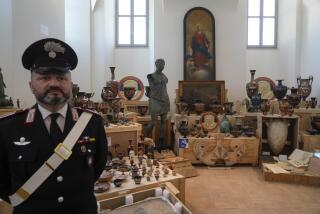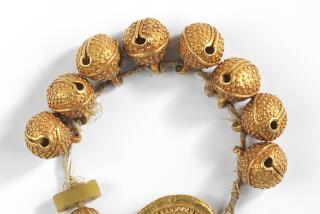FBI Agents Take Artful Tack on Crime
PHILADELPHIA — Over the last few years, FBI Special Agent Robert K. Wittman has gone undercover to recover millions of dollars worth of stolen goods.
Not drugs. Or guns. Or counterfeit cash. This G-man tracks down stolen art. Wittman is one of a trio of FBI special agents who specialize in recovering objects of cultural heritage pilfered from museums and private collections.
He has recovered a number of priceless objects, ranging from Civil War-era swords and rifles stolen from a historical society to a smuggled piece of ancient Peruvian body armor worth $1.6 million.
For Wittman, finding stolen art gets personal.
“If you take a 2,000-year-old piece of history away from Peru, you’re destroying the cultural heritage of that people,” he said. “You’re taking away the opportunity for them to see something beautiful their ancestors made.
“It’s a crime against humanity.”
When the Historical Society of Pennsylvania discovered several missing items last year during a computerized inventory of its 12,000 artifacts, they called the FBI.
Led by Wittman, who posed as an art dealer, the FBI team uncovered more than 200 items smuggled out during a 10-year period and arrested a museum janitor and a Civil War collector in January.
Included in the recovered booty was a sword presented to Union Gen. George Meade after the Battle of Gettysburg and a rifle used by abolitionist John Brown during his raid at Harpers Ferry, W.Va.
The recovery of the items--each valued at between $2 million and $3 million--was a triumph for the FBI’s stolen-art team.
“You can read all you want about history,” Wittman said. “But to touch George Washington’s tea caddy or hold John Brown’s rifle brings it all home.”
Reared in Baltimore, Wittman grew up among art and memorabilia at his family’s antique shop. “I was always into old stuff,” he said with a smile.
That appreciation carried over when he joined the FBI a decade ago. It helps fuel his desire to protect the past from selfish hands.
The first step is getting museums to ask for help in tracking down stolen artifacts. Institutions and museums are often reluctant to report art thefts, afraid of publicity or the stigma that might reduce donations.
The FBI has been aided by what Wittman calls the “big hammer”--the 1994 federal Theft of Major Artwork statute, which gives the FBI jurisdiction over thefts from museums, public institutions and libraries.
The statute provides for a maximum penalty of 10 years in prison and a fine for anyone convicted of stealing an item more than 100 years old and worth more than $5,000.
Wittman, 42, said he gets a thrill out of finding stolen relics that his grandchildren may one day see hanging on a wall, rather than wrapped in a towel in someone’s basement.
But he downplays his own efforts, saying an “investigation is an investigation, whether it’s a Monet or a Cadillac.”
“When these cases come out, he gets excited and he wants to solve them,” federal prosecutor Robert Goldman said. “He enjoys being the good guy.”
More to Read
Sign up for Essential California
The most important California stories and recommendations in your inbox every morning.
You may occasionally receive promotional content from the Los Angeles Times.










